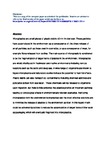Microplastics in the Environment
| dc.contributor.author | Thompson, Richard | |
| dc.contributor.author | Napper, I | |
| dc.date.accessioned | 2019-04-04T22:09:25Z | |
| dc.date.available | 2019-04-04T22:09:25Z | |
| dc.date.issued | 2019-01-01 | |
| dc.identifier.isbn | 978-1-78801-241-6 | |
| dc.identifier.uri | http://hdl.handle.net/10026.1/13644 | |
| dc.description.abstract |
© The Royal Society of Chemistry 2019. Microplastics are small pieces of plastic debris less than 5 mm in diameter. They have accumulated in the environment as a consequence of: the direct release of small particles, such as those used in cosmetics; or as a consequence of wear, for example fibres released from textiles. The main source of microplastic is considered to be the fragmentation of larger items of plastics in the environment. Microplastics are widely distributed in freshwater and marine environments including remote locations such as the arctic and deep sea. A wide range of organisms are known to ingest microplastics and laboratory studies indicate the potential for harmful effects. Plastic debris can also transport co-contaminants including chemical additives and pollutants sorbed from sea water. These chemicals can be released to organisms upon ingestion, but there is little evidence that plastics provide an important pathway leading to toxicological effects in environmentally relevant scenarios. Removing microplastics from the environment is impractical and the most effective solutions are to minimise the release of plastics to the environment as litter. In this regard much could be achieved by actions to reduce the accumulation of larger items of litter such as packaging, which will eventually fragment into microplastics. | |
| dc.format.extent | 60-81 | |
| dc.language.iso | en | |
| dc.publisher | Royal Society of Chemistry | |
| dc.relation.ispartof | Plastics and the Environment | |
| dc.title | Microplastics in the Environment | |
| dc.type | chapter | |
| plymouth.volume | 2019-January | |
| plymouth.publication-status | Published | |
| dc.identifier.doi | 10.1039/9781788013314-00060 | |
| plymouth.organisational-group | /Plymouth | |
| plymouth.organisational-group | /Plymouth/Faculty of Science and Engineering | |
| plymouth.organisational-group | /Plymouth/Faculty of Science and Engineering/School of Biological and Marine Sciences | |
| plymouth.organisational-group | /Plymouth/REF 2021 Researchers by UoA | |
| plymouth.organisational-group | /Plymouth/REF 2021 Researchers by UoA/UoA07 Earth Systems and Environmental Sciences | |
| plymouth.organisational-group | /Plymouth/Research Groups | |
| plymouth.organisational-group | /Plymouth/Research Groups/Marine Institute | |
| plymouth.organisational-group | /Plymouth/Users by role | |
| plymouth.organisational-group | /Plymouth/Users by role/Academics | |
| plymouth.organisational-group | /Plymouth/Users by role/Researchers in ResearchFish submission | |
| dc.rights.embargoperiod | Not known | |
| rioxxterms.versionofrecord | 10.1039/9781788013314-00060 | |
| rioxxterms.licenseref.uri | http://www.rioxx.net/licenses/all-rights-reserved | |
| rioxxterms.type | Book chapter |


